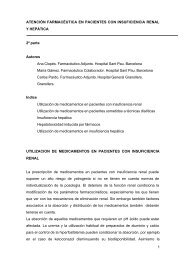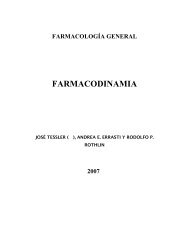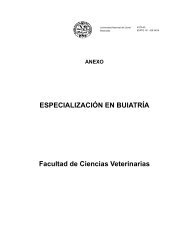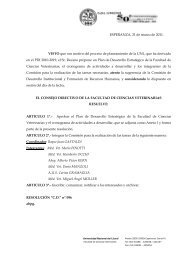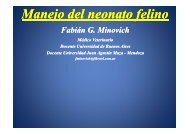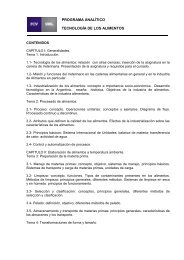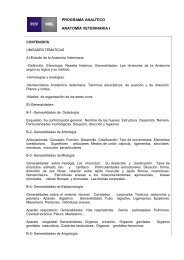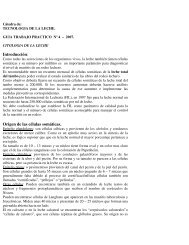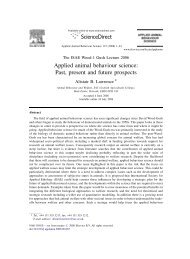- Page 3 and 4: Página 3 de 11El CCPA de hoyProgra
- Page 5 and 6: Página 5 de 11A. INTRODUCCIÓNB. P
- Page 7: Página 7 de 111. AdquisiciónTrans
- Page 11 and 12: Página 11 de 11XVII.Glosario[ De n
- Page 13 and 14: Página 2 de 7El CCPA está muy agr
- Page 15 and 16: Página 4 de 7Dr. Santiago Urcelay,
- Page 17 and 18: Página 6 de 7Vancouver, B.C. V6T 1
- Page 19 and 20: Página 1 de 3Contact Us | Site Map
- Page 21: Página 3 de 3Sociedad Real de Cana
- Page 24 and 25: Página 3 de 20Los comités del CCP
- Page 26 and 27: Página 5 de 204. Declaraciones de
- Page 28 and 29: Página 7 de 20(CCPA)..." (Stewart,
- Page 32: Página 11 de 20d) por lo menos, un
- Page 35 and 36: Página 14 de 20La disponibilidad d
- Page 37 and 38: Página 16 de 20c) Personal para el
- Page 39 and 40: Página 18 de 2037. HAMPSON, J. The
- Page 41 and 42: Página 20 de 20About CCAC | What's
- Page 43 and 44: Página 2 de 8de los animales o de
- Page 45 and 46: Página 4 de 8d) Almacenaje del equ
- Page 47 and 48: Página 6 de 8sociales por naturale
- Page 49 and 50: Página 8 de 86. INTERNATIONAL AIR
- Page 51 and 52: Página 2 de 12En casos especiales,
- Page 53 and 54: Página 4 de 12Los efectos del ruid
- Page 55 and 56: Página 6 de 12La densidad de pobla
- Page 57 and 58: Página 8 de 12- Las salidas de las
- Page 59 and 60:
Página 10 de 1217. CLOUGH, G. The
- Page 61 and 62:
Página 12 de 1254. SMALL, J.D. Env
- Page 63 and 64:
Página 2 de 17para el ganado y las
- Page 65 and 66:
Página 4 de 17regiones con lluvias
- Page 67 and 68:
Página 6 de 17i) TemperaturaLos ra
- Page 69 and 70:
Página 8 de 17mm de alambre, de me
- Page 71 and 72:
Página 10 de 1775 165 0.62 (6.7) 0
- Page 73 and 74:
Página 12 de 17Todos los gallinero
- Page 75 and 76:
Página 14 de 17Cercados sobre tier
- Page 77 and 78:
Página 16 de 1720. GENTLE, M. Meas
- Page 79 and 80:
Página 1 de 11Contact Us | Site Ma
- Page 81 and 82:
Página 3 de 11diferentes, también
- Page 83 and 84:
Página 5 de 11bacteriológicos.Se
- Page 85 and 86:
Página 7 de 11Los animales muertos
- Page 87 and 88:
Página 9 de 11impregnated collars
- Page 89 and 90:
Página 11 de 1145. RIEGER, D. and
- Page 91 and 92:
Página 2 de 55Hurnik (1988) define
- Page 93 and 94:
Página 4 de 55e) el derecho de viv
- Page 95 and 96:
Página 6 de 55Los animales guardad
- Page 97 and 98:
Página 8 de 55domésticos, el bien
- Page 99 and 100:
Página 10 de 55demostradas con ant
- Page 101 and 102:
Página 12 de 55para una caja de ci
- Page 103 and 104:
Página 14 de 55característica pre
- Page 105 and 106:
Página 16 de 55Los perros que ladr
- Page 107 and 108:
Página 18 de 55los perros y de var
- Page 109 and 110:
Página 20 de 55Las personas que tr
- Page 111 and 112:
Página 22 de 55que los humanos en
- Page 113 and 114:
Página 24 de 55prevenir o impedir
- Page 115 and 116:
Página 26 de 55El suplemento alime
- Page 117 and 118:
Página 28 de 55Se deberían evalua
- Page 119 and 120:
Página 30 de 55jaula provee oportu
- Page 121 and 122:
Página 32 de 55H. ANIMALES SILVEST
- Page 123 and 124:
Página 34 de 5532. BLACKSHAW, J.K.
- Page 125 and 126:
Página 36 de 5570. ERWIN, J. Envir
- Page 127 and 128:
Página 38 de 55108. HOBBS, K.R. Ha
- Page 129 and 130:
Página 40 de 55145. MCGLONE, J.J.
- Page 131 and 132:
Página 42 de 551984: 241-271.182.
- Page 133 and 134:
Página 44 de 551985; 14(1): 33-36.
- Page 135 and 136:
Página 46 de 55259. BLACKSHAW, J.K
- Page 137 and 138:
Página 48 de 55300. FOX, M.W. Envi
- Page 139 and 140:
Página 50 de 55337. MCGREW, W.C. S
- Page 141 and 142:
Página 52 de 55376. RYON, J.C. Asp
- Page 143 and 144:
Página 54 de 55Mono arañaMacaco r
- Page 145 and 146:
Página 1 de 14Contact Us | Site Ma
- Page 147 and 148:
Página 3 de 14manipulaciones (es d
- Page 149 and 150:
Página 5 de 14cesárea sean usados
- Page 151 and 152:
Página 7 de 14iv) Para asegurarse
- Page 153 and 154:
Página 9 de 14este método particu
- Page 155 and 156:
Página 11 de 14handling and experi
- Page 157 and 158:
Página 13 de 14studies to a new an
- Page 159 and 160:
Página 1 de 9Contact Us | Site Map
- Page 161 and 162:
Página 3 de 9potenciales. Por ejem
- Page 163 and 164:
Página 5 de 9E. ALERGIASLas alergi
- Page 165 and 166:
Página 7 de 911. AUGUST, J.R. and
- Page 167 and 168:
Página 9 de 9[ Capítulo Anterior
- Page 169 and 170:
Página 2 de 8El lugar donde se des
- Page 171 and 172:
Página 4 de 8del cirujano incluir
- Page 173 and 174:
Página 6 de 8F. REFERENCIAS1. ACAD
- Page 175 and 176:
Página 8 de 8CONEJOGATOPERROPÁJAR
- Page 177 and 178:
Página 2 de 18Wall (1992) sugiere
- Page 179 and 180:
Página 4 de 18E. SEÑALES DE DOLOR
- Page 181 and 182:
Página 6 de 18tono de la piel no e
- Page 183 and 184:
Página 8 de 18CaballosSe observan
- Page 185 and 186:
Página 10 de 18se pueden producir
- Page 187 and 188:
Página 12 de 18los troncos especí
- Page 189 and 190:
Página 14 de 181989; 16: 212.10. B
- Page 191 and 192:
Página 16 de 18Animal Welfare), 19
- Page 193 and 194:
Página 18 de 1891. TOTH, L.A. and
- Page 195 and 196:
Página 2 de 16perturba los sistema
- Page 197 and 198:
Página 4 de 16el efecto de depresi
- Page 199 and 200:
Página 6 de 16profundidad de la an
- Page 201 and 202:
Página 8 de 16E. ANESTÉSICOS LOCA
- Page 203 and 204:
Página 10 de 16una recuperación r
- Page 205 and 206:
Página 12 de 16anestésicos a anfi
- Page 207 and 208:
Página 14 de 1635. LIPMAN, N.S., M
- Page 209 and 210:
Página 16 de 16© 2005 CCAC, All R
- Page 211 and 212:
Página 2 de 17B. CRITERIOS PARA UN
- Page 213 and 214:
Página 4 de 17(Clifford, 1984). Cu
- Page 215 and 216:
Página 6 de 17ahora, estos mismos
- Page 217 and 218:
Página 8 de 17anestésicos por inh
- Page 219 and 220:
Página 10 de 17anatomía. El metan
- Page 221 and 222:
Página 12 de 17y de angustia. Por
- Page 223 and 224:
Página 14 de 1726. CANADIAN COUNCI
- Page 225 and 226:
Página 16 de 17Bar, Herts, England
- Page 227 and 228:
Página 1 de 10Contact Us | Site Ma
- Page 229 and 230:
Página 3 de 103. Una hipótesis b
- Page 231 and 232:
Página 5 de 101. Antes de emprende
- Page 233 and 234:
Página 7 de 10enfermedad y el dolo
- Page 235 and 236:
Página 9 de 10contribución sustan
- Page 237 and 238:
Página 1 de 3Contact Us | Site Map
- Page 239 and 240:
Página 3 de 3se deben utilizar rel
- Page 241 and 242:
Página 2 de 2CABRA 1.4 m 2 2.0 m 1
- Page 243 and 244:
Página 2 de 2NOHUMANOBabuíno(Papi
- Page 245 and 246:
Página 2 de 3RATÓNPRIMATENOHUMANO
- Page 247 and 248:
Página 1 de 3Contact Us | Site Map
- Page 249 and 250:
Página 3 de 3About CCAC | What's n
- Page 251 and 252:
Página 2 de 3BR) eCF-1 (Crl:CF- 9.
- Page 253 and 254:
Página 1 de 3Contact Us | Site Map
- Page 255 and 256:
Página 3 de 3About CCAC | What's n
- Page 257 and 258:
Página 2 de 6Clamidiosis 3Psitacos
- Page 259 and 260:
Página 4 de 6Virus de la garrapata
- Page 261 and 262:
Página 6 de 61 Solo las especies h
- Page 263 and 264:
Página 2 de 6Referenciasa ADAMS, C
- Page 265 and 266:
Página 4 de 6RANA XgGERBO Xv Xv Xv
- Page 267 and 268:
Página 6 de 6and management of lab
- Page 269 and 270:
Página 2 de 2IV 0.2RATA 2.5 IP 2.5
- Page 271 and 272:
Página 2 de 2PRIMATESNOHUMANOSPO10
- Page 273 and 274:
Página 2 de 2cEl Saffan es útil p
- Page 275 and 276:
Página 2 de 3TortugaLagartoSerpien
- Page 277 and 278:
Página 1 de 3Contact Us | Site Map
- Page 279 and 280:
Página 3 de 3Gas carbónicoSalmón
- Page 281 and 282:
Página 2 de 3EQUINOS (caballos) Ba
- Page 283 and 284:
Página 1 de 6Contact Us | Site Map
- Page 285 and 286:
Página 3 de 69. Los experimentos d
- Page 287 and 288:
Página 5 de 6Cuando se empieza una
- Page 289 and 290:
Página 1 de 2Contact Us | Site Map
- Page 291 and 292:
Página 1 de 9Contact Us | Site Map
- Page 293 and 294:
Página 3 de 9CELO: Período durant
- Page 295 and 296:
Página 5 de 9FERTILIZACIÓN: La un
- Page 297 and 298:
Página 7 de 9MUTANTE: Organismo qu
- Page 299:
Página 9 de 9SUSCEPTIBLE: Que tien




